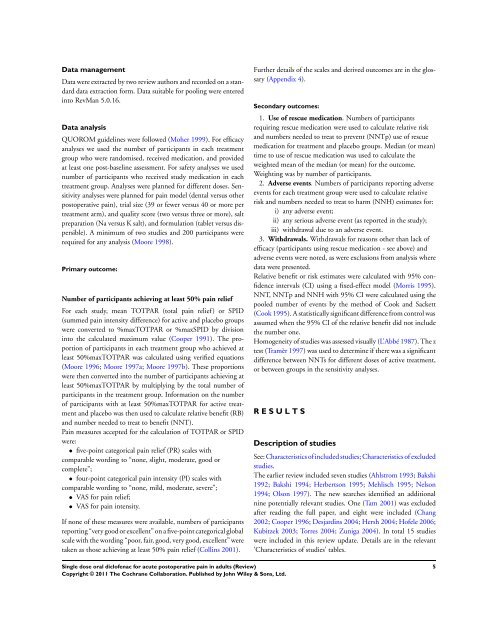Single dose oral diclofenac for acute postoperative pain in adults
Single dose oral diclofenac for acute postoperative pain in adults
Single dose oral diclofenac for acute postoperative pain in adults
Create successful ePaper yourself
Turn your PDF publications into a flip-book with our unique Google optimized e-Paper software.
Data managementData were extracted by two review authors and recorded on a standarddata extraction <strong>for</strong>m. Data suitable <strong>for</strong> pool<strong>in</strong>g were entered<strong>in</strong>to RevMan 5.0.16.Data analysisQUOROM guidel<strong>in</strong>es were followed (Moher 1999). For efficacyanalyses we used the number of participants <strong>in</strong> each treatmentgroup who were randomised, received medication, and providedat least one post-basel<strong>in</strong>e assessment. For safety analyses we usednumber of participants who received study medication <strong>in</strong> eachtreatment group. Analyses were planned <strong>for</strong> different <strong>dose</strong>s. Sensitivityanalyses were planned <strong>for</strong> <strong>pa<strong>in</strong></strong> model (dental versus other<strong>postoperative</strong> <strong>pa<strong>in</strong></strong>), trial size (39 or fewer versus 40 or more pertreatment arm), and quality score (two versus three or more), saltpreparation (Na versus K salt), and <strong>for</strong>mulation (tablet versus dispersible).A m<strong>in</strong>imum of two studies and 200 participants wererequired <strong>for</strong> any analysis (Moore 1998).Primary outcome:Number of participants achiev<strong>in</strong>g at least 50% <strong>pa<strong>in</strong></strong> reliefFor each study, mean TOTPAR (total <strong>pa<strong>in</strong></strong> relief) or SPID(summed <strong>pa<strong>in</strong></strong> <strong>in</strong>tensity difference) <strong>for</strong> active and placebo groupswere converted to %maxTOTPAR or %maxSPID by division<strong>in</strong>to the calculated maximum value (Cooper 1991). The proportionof participants <strong>in</strong> each treatment group who achieved atleast 50%maxTOTPAR was calculated us<strong>in</strong>g verified equations(Moore 1996; Moore 1997a; Moore 1997b). These proportionswere then converted <strong>in</strong>to the number of participants achiev<strong>in</strong>g atleast 50%maxTOTPAR by multiply<strong>in</strong>g by the total number ofparticipants <strong>in</strong> the treatment group. In<strong>for</strong>mation on the numberof participants with at least 50%maxTOTPAR <strong>for</strong> active treatmentand placebo was then used to calculate relative benefit (RB)and number needed to treat to benefit (NNT).Pa<strong>in</strong> measures accepted <strong>for</strong> the calculation of TOTPAR or SPIDwere:• five-po<strong>in</strong>t categorical <strong>pa<strong>in</strong></strong> relief (PR) scales withcomparable word<strong>in</strong>g to “none, slight, moderate, good orcomplete”;• four-po<strong>in</strong>t categorical <strong>pa<strong>in</strong></strong> <strong>in</strong>tensity (PI) scales withcomparable word<strong>in</strong>g to “none, mild, moderate, severe”;• VAS <strong>for</strong> <strong>pa<strong>in</strong></strong> relief;• VAS <strong>for</strong> <strong>pa<strong>in</strong></strong> <strong>in</strong>tensity.If none of these measures were available, numbers of participantsreport<strong>in</strong>g “very good or excellent” on a five-po<strong>in</strong>t categorical globalscale with the word<strong>in</strong>g “poor, fair, good, very good, excellent” weretaken as those achiev<strong>in</strong>g at least 50% <strong>pa<strong>in</strong></strong> relief (Coll<strong>in</strong>s 2001).Further details of the scales and derived outcomes are <strong>in</strong> the glossary(Appendix 4).Secondary outcomes:1. Use of rescue medication. Numbers of participantsrequir<strong>in</strong>g rescue medication were used to calculate relative riskand numbers needed to treat to prevent (NNTp) use of rescuemedication <strong>for</strong> treatment and placebo groups. Median (or mean)time to use of rescue medication was used to calculate theweighted mean of the median (or mean) <strong>for</strong> the outcome.Weight<strong>in</strong>g was by number of participants.2. Adverse events. Numbers of participants report<strong>in</strong>g adverseevents <strong>for</strong> each treatment group were used to calculate relativerisk and numbers needed to treat to harm (NNH) estimates <strong>for</strong>:i) any adverse event;ii) any serious adverse event (as reported <strong>in</strong> the study);iii) withdrawal due to an adverse event.3. Withdrawals. Withdrawals <strong>for</strong> reasons other than lack ofefficacy (participants us<strong>in</strong>g rescue medication - see above) andadverse events were noted, as were exclusions from analysis wheredata were presented.Relative benefit or risk estimates were calculated with 95% confidence<strong>in</strong>tervals (CI) us<strong>in</strong>g a fixed-effect model (Morris 1995).NNT, NNTp and NNH with 95% CI were calculated us<strong>in</strong>g thepooled number of events by the method of Cook and Sackett(Cook 1995). A statistically significant difference from control wasassumed when the 95% CI of the relative benefit did not <strong>in</strong>cludethe number one.Homogeneity of studies was assessed visually (L’Abbé 1987). The ztest (Tramèr 1997) was used to determ<strong>in</strong>e if there was a significantdifference between NNTs <strong>for</strong> different <strong>dose</strong>s of active treatment,or between groups <strong>in</strong> the sensitivity analyses.R E S U L T SDescription of studiesSee: Characteristics of <strong>in</strong>cluded studies; Characteristics of excludedstudies.The earlier review <strong>in</strong>cluded seven studies (Ahlstrom 1993; Bakshi1992; Bakshi 1994; Herbertson 1995; Mehlisch 1995; Nelson1994; Olson 1997). The new searches identified an additionaln<strong>in</strong>e potentially relevant studies. One (Tam 2001) was excludedafter read<strong>in</strong>g the full paper, and eight were <strong>in</strong>cluded (Chang2002; Cooper 1996; Desjard<strong>in</strong>s 2004; Hersh 2004; Hofele 2006;Kubitzek 2003; Torres 2004; Zuniga 2004). In total 15 studieswere <strong>in</strong>cluded <strong>in</strong> this review update. Details are <strong>in</strong> the relevant’Characteristics of studies’ tables.<strong>S<strong>in</strong>gle</strong> <strong>dose</strong> <strong>oral</strong> <strong>diclofenac</strong> <strong>for</strong> <strong>acute</strong> <strong>postoperative</strong> <strong>pa<strong>in</strong></strong> <strong>in</strong> <strong>adults</strong> (Review)Copyright © 2011 The Cochrane Collaboration. Published by John Wiley & Sons, Ltd.5












